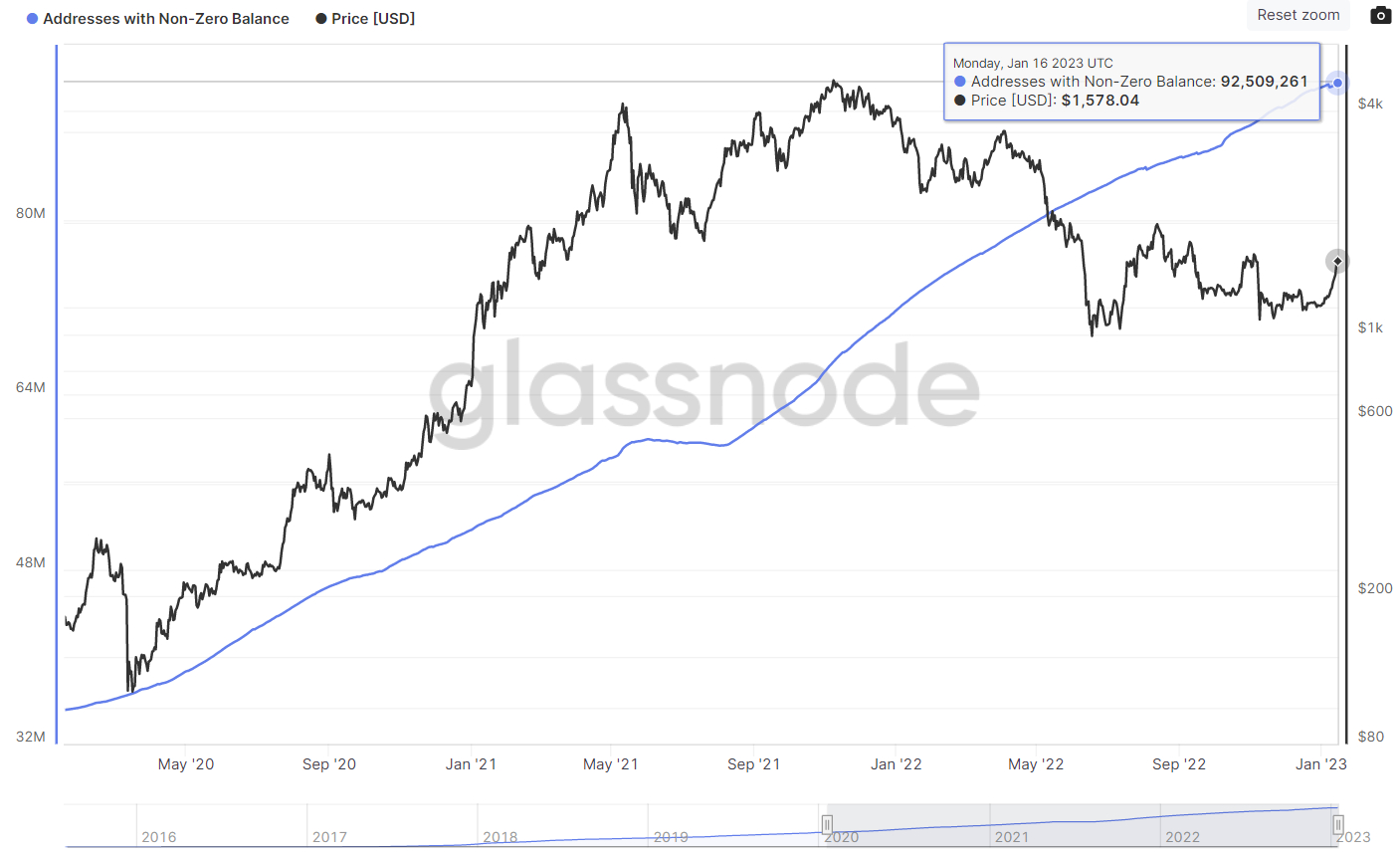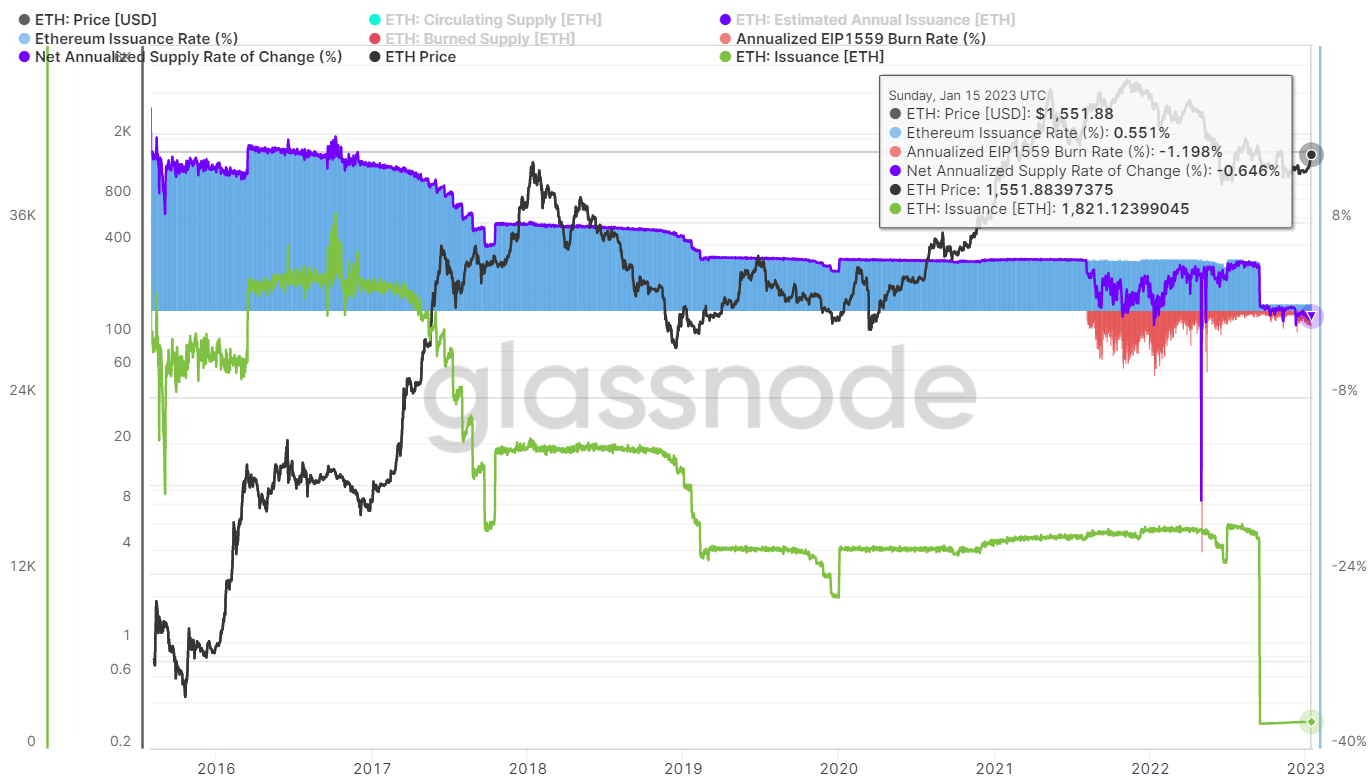[ad_1]

The number of Ethereum addresses holding a non-zero balance hit a new record high on Monday of 92.5 million. 2022’s bear market, which culminated in the collapse of one of the world’s former largest cryptocurrency exchanges in November, does not appear to have impacted growth in the number of non-zero balance addresses.

Some analysts view the number of Ethereum addresses holding a non-zero balance as a proxy for the second-largest cryptocurrency by market capitalization’s broader “adoption”. Viewed through that lense, the continued, seemingly unstoppable rise of the number of non-zero balance Ethereum addresses can be interpreted as a long-term bullish sign for the ETH cryptocurrency.
100 Million Non-zero Address Wallets in Q2?
Over the last three years, Ethereum has added about 20 million addresses holding a non-zero balance per year. Back of the fag box calculation thus implies that, with only around 7.5 million to go, the 100 million address mark will probably be hit sometime in Q2 2023.
This will undoubtedly be big news. Cryptocurrency markets are notoriously fickle when it comes to responding to market narratives. Traders shouldn’t be too surprised to see ETH get a boost in the run-up/immediate aftermath of the 100 million non-zero address mark getting hit amid all the hype and positive press the accomplishment will likely attract.
Other Metrics Also Signal Continued Strong Network Growth
Growth in the number of non-zero balance Ethereum is viewed by some as an overly crude metric – each new non-zero address doesn’t necessarily mean a new Ethereum user. Luckily for the Ethereum bulls, there are a long list of other metrics that also point to strong continued network growth.
A recently released report from blockchain software development company Alchemy, the number of smart contracts deployed on the Ethereum mainnet grew a staggering near 300% in 2022. That means that smart contract deployment growth roughly matched its rate of increase seen in 2021, despite 2022’s bear market. There were 4.6 million smart contracts deployed on the Ethereum blockchain at the end of Q4 2022, the report noted.
“The Web3 developer community is proving to be extremely resilient,” commented Jason Shah, Alchemy’s head of growth. “This report shows that they’re as focused and motivated as ever to build the future of this ecosystem—while honestly acknowledging the unnecessary setbacks we have seen in 2022,” he added.
Elsewhere, the number of Ethereum network validators recently surpassed 500,000. It surpassed 400,000 only as recently as last July. A network validator is a computer that runs software that verifies and validates transactions on the blockchain. A higher number of validators is seen as a sign of network strength, as it implies it would be more difficult for a malicious group of validators to gain control of the network and corrupt the blockchain.
Ethereum Deflation Another Narrative to Gain Ground in 2023
The bear market in cryptocurrency markets that began just over a year ago means that Ethereum’s price decline (ETH is down about 67.5% from its record highs printed in November 2021) has been the dominant story in recent quarters.
But a key change was made in September 2022 to the Ethereum protocol that is likely to give the cryptocurrency a major long-term boost. Last September, Ethereum transitioned from using a proof-of-work consensus mechanism to using the much less energy-intensive proof-of-stake consensus mechanism.
Not only does that reduce concerns about the cryptocurrency’s environmental impact, which might help it attract institutional capital flows in the coming years where Ethereum’s much more energy-intensive rival Bitcoin might struggle, but Ethereum’s inflation rate has also dropped sharply.
Indeed, as of Sunday the 15th of January, Ethereum’s annual issuance rate was around 0.55%, while its burn rate was just under 1.2%. As a result, Ethereum is currently experiencing deflation at a rate of around 0.65% per year. Back when Ethereum was still a proof-of-work blockchain, its inflation rate was 4-5%.

Some analysts have posited that the deflationary impact of the Merge may have been what helped prevent ETH from falling back under $1,000 and hitting fresh annual lows in the immediate aftermath of the FTX collapse. For contrast, Bitcoin did hit fresh annual lows in wake of the FTX debacle.
Ethereum will soon undergo its next major upgrade. The “Shanghai” hard-fork is expected in March and will allow staked ETH to be withdrawn for the first time, a change which is touted to be a big positive for the protocol as it will likely encourage more investors to stake their ETH.
[ad_2]
cryptonews.com




